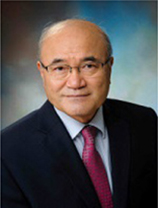Jin Mo Chung, PhD
Professor Emeritus

Education and Training
BS in Physics, Sogang University, Seoul, Korea
PhD in Physiology, Loyola-Stritch School of Medicine, Maywood, IL
Post-Doctoral in Neurophysiology, Loyola-Stritch School of Medicine, Maywood, IL
Post-Doctoral in Somatosensory Neurophysiology, University of Texas Medical Branch, Galveston, TX
Research Interests
Basic Science Research: I am a lifelong basic biomedical science researcher, focusing on the mechanisms of chronic pain, especially neuropathic pain. My most notable contribution to the field of pain is the development of a rodent model of chronic neuropathic pain referred to as the “spinal nerve ligation (SNL)” model, nicknamed the “Chung Model.” This model is used worldwide in the testing and development of new analgesic drugs for managing human chronic pain. My current research focus is on the synaptic plasticity of pain transmission pathways, involvement of reactive oxygen species in chronic pain and the development of various pain treatment strategies, using several animal pain models representing different disease conditions such as spinal cord injury, diabetic neuropathy, HIV infection, and chemotherapy induced pain. During my career, I have published more than 160 papers in peer-reviewed journals and these papers have been cited more than 23,000 times in the literature. For the past 35 years, my research has been supported by NIH research awards, including multiple R01s and Program Project Grants.
Medical and Graduate Education: I have taught at the University of Texas Medical Branch in Galveston for over 30 years in the Basic Neuroscience Course for graduate and medical students and have mentored 22 visiting scientists and 30 postdoctoral fellows to date. I have been an invited speaker to at least 75 different symposiums, world congresses, seminars and workshops and have presented in Korea, Germany, France, England, and from the east to west coasts of the United States. I served as a charter member of two NIH study sections for grant review and numerous ad-hoc study sections. I am a founding member of the Association of Korean Neuroscientists, the inaugural Director of Gulf Coast Consortium for Translational Pain Research, and the inaugural Co-Director of the newly formed Texas Pain Research Consortium.
Selected Publications
Kim, S.H. and Chung, J.M. An experimental model for peripheral neuropathy produced by segmental spinal nerve ligation in the rat. Pain 50:355-363, 1992 (cited more than 3,000 times).
Kim, K.J., Yoon, Y.W. and Chung, J.M. Comparison of three rodent neuropathic pain models. Exp. Brain Res. 113:200-206, 1997 (cited more than 400 times).
Kim, C.H., Oh, Y.S., Chung, J.M. and Chung, K. The changes in expression of three subtypes of TTX sensitive sodium channels in sensory neurons after spinal nerve ligation. Molecular Brain Research 95:153-161, 2001 (cited more than 160 times).
Kim, H.K., Park, S.K., Zhou, J., Taglialatela, G., Chung, K., Coggeshall, R.E. and Chung, J.M. Reactive oxygen species (ROS) play an important role in a rat model of neuropathic pain. Pain 111:116-124, 2001 (cited more than 340 times).
Schwartz, E.S., Kim, H.Y., Wang, J., Lee, I., Klann, E., Chung, J.M. and Chung, K. Persistent pain is dependent on spinal mitochondrial antioxidant levels. J. Neurosci. 29:159-168, 2009 (cited more than 95 times).
Kim, H.Y., Lee, K.Y., Lu, Y., Wang, J., Cui, L., Kim, S.J. , Chung, J.M. and Chung, K. Mitochondrial Ca2+ uptake is essential for synaptic plasticity in pain. J. Neurosci. 31:12982-12991, 2011 (cited more than 45 times).
Yowtak, J., Wang, J., Kim, H.Y., Lu, Y., Chung, K. and Chung, J.M. Effect of antioxidant treatment on spinal GABA neurons in a neuropathic pain model in the mouse. Pain 154:2409-2476, 2013 (cited more than 30 times).
Kim, H.Y., Jun, J., Wang, J., Bittar, A., Chung, K. and Chung, J.M. The induction of LTP and LTD is cell-type specific in the spinal cord. Pain 156:618-625, 2015.